#king harald fairhair
Explore tagged Tumblr posts
Text
5 facts about your OC
Tagged by: @thewanderer-000 thank you!! 😁💙
Tagging: @athena-lilly @the-chaos-katzlein @inafieldofdaisies
Rules: Post 5 facts about your OC.
Here are some facts for Liv since she's my new OC. Paige and Kate have had their time in my OC spotlight, giving it to my Saxon/Norse gal.

1. She was to be married to King Harald Fairhair but was able to escape the arranged married, she only agree to it so she could plot her next escape. She also had a relationship with Ubba Ragnarsson prior to her and Eivor.
2. When she gets upset or irritated, her thick Saxon accent comes out. She normally speaks with the standard Norse accent.
3. She has a list of people that she plots to kill. She's friends with everyone, but there are some people who she doesn't trust and rub her the wrong way, or have ruined her life at some point.
4. She had a rational fear of men. Arriving in England, she became acquainted with Eivor, Gunnar, Ubba, Ceolbert, and a few others. She was friends with the women of the Raven Clan. (She went through a MASSIVE character development)
5. She has 3 foxes, Runa, Evary and Ljós. Whom she refers to as her children. She's also an icon for introverts, her way of having fun during feasts is watching everyone else make themselves look like fools.
#oc: liv eldrid#oc: liv redfox#oc: liv grímsdóttir#ac: valhalla oc#ac: valhalla#assassins creed valhalla oc#assassins creed valhalla#oc facts#my ocs#my oc#my oc facts#ubba ragnarsson#eivor varinsson#king harald fairhair
29 notes
·
View notes
Text

Actually enjoyed working on this one so much that I might draw Harald again hehe
[see hq or get copies]
#my art#pen art#vikings#history vikings#harald finehair#harald fairhair#harald halfdansson#king harald#Peter Franzen#art#drawing#fanart#pen artwork#ink#ink sketch
22 notes
·
View notes
Text
Being Haralds Woman Would Include...
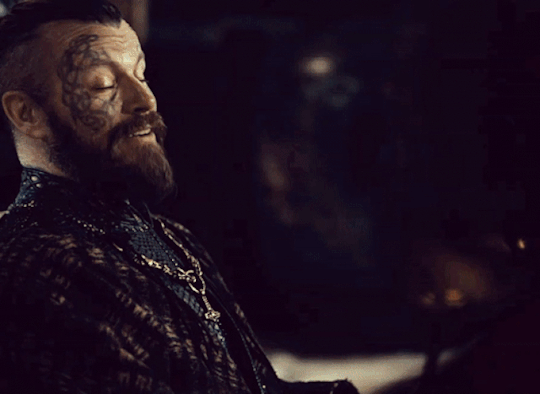
Being his woman would almost feel unreal because of all the things he does for you and also give to you. He loves to spoil you with things because of the money he has. He loves to surprise you with wonderful jewelry and new dresses almost all the time (He would love to get new dresses just to show off your breasts because he just loves them so much, and he technically has to get you new dresses a lot because he seems to always rip them off you when you two are trying to have sex.) He loves complimenting you all the time as well. He just loves seeing you smile and get shy. That is another thing he loves, is you getting shy. He will purposely say something sexual or even do something sexual to you in public and loves to watch you get shy and nervous. He even likes to see you get shy when he just says he loves you in public. being his woman has multiple perks but the only downside of him being king of all Norway would be that he is gone a lot and has meetings a lot as well during the days and nights. But of course he always makes it up to you in the end because he would hate for you to dislike him or hate being in the relationship with him. He loves you way to much to lose you in any way.
#harald finehair#harald x reader#norway#harald#scandanavia#harald fairhair#harald fairhair x reader#viking#vikings#imagines#norse#nordic#king harald#king of norway#his woman#vikings imagines#vikings headcanon#vikings harald#viking imagine
94 notes
·
View notes
Text
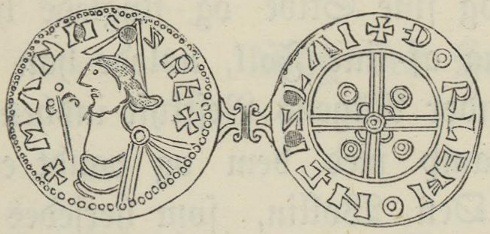
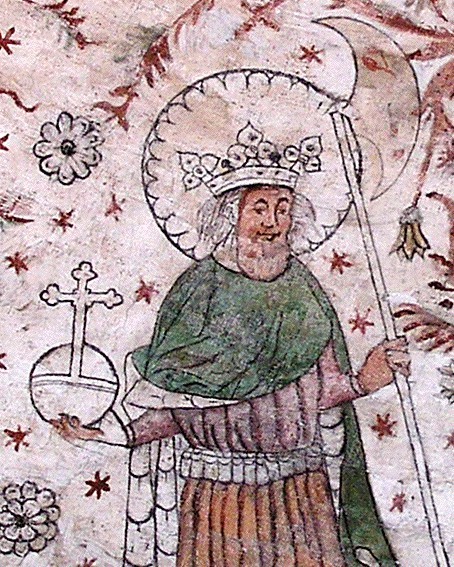

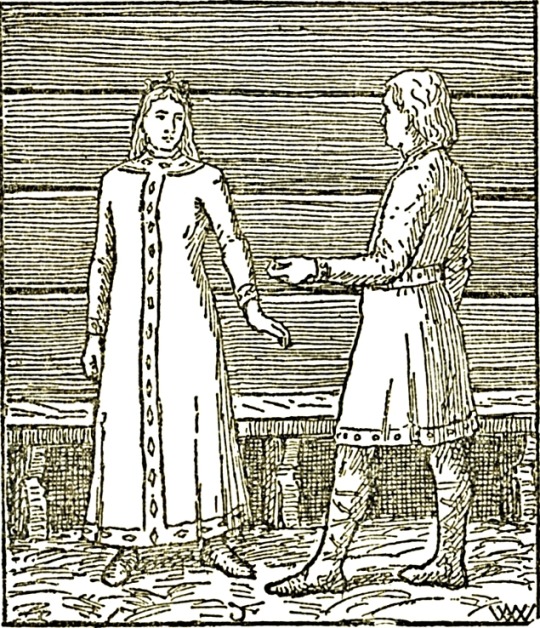
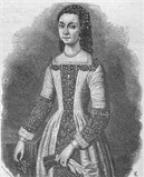

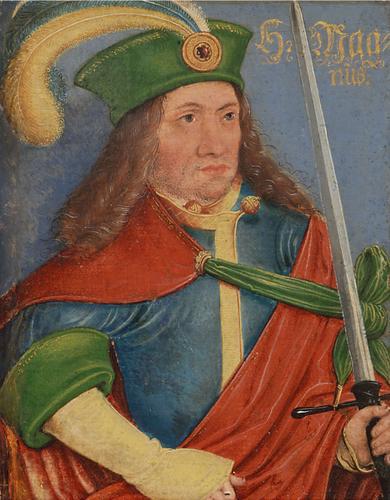
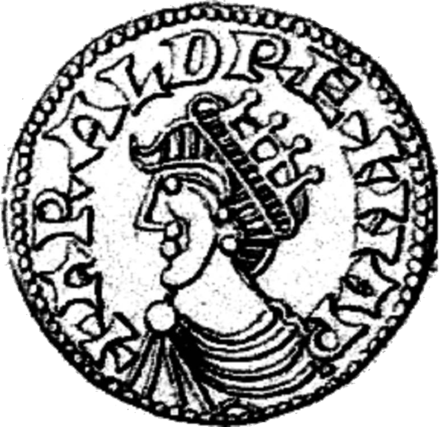
The Bastard Kings and their families
This is series of posts are complementary to this historical parallels post from the JON SNOW FORTNIGHT EVENT, and it's purpouse to discover the lives of medieval bastard kings, and the following posts are meant to collect portraits of those kings and their close relatives.
In many cases it's difficult to find contemporary art of their period, so some of the portrayals are subsequent.
1) Magnus I of Norway (c. 1015 – 1066), son of Olaf II of Norway and Alfhild
2) His father, Olaf II of Norway (c. 995 – 1030), son of Harald Grenske and his wife Åsta Gudbrandsdatter
3) His great-great-grandfather, Harald Fairhair (c. 850 – c. 932), son of Halfdan the Black and his wife Ragnhild Sigurdsdatter
4) His daughter, Ragnhild Magnusdatter; with her husband Haakon Ivarsson
5) His sister, Wulfhild of Norway (1020 – 1071), daughter of Olaf II of Norway and his wife Astrid Olofsdotter
6) His brother-in-law, Ordulf of Saxony (c. 1022 – 1072), son of Bernard II of Saxony and his wife Eilika of Schweinfurt
7) His nephew, Magnus of Saxony (c. 1045 –1106), son of Wulfhild of Norway and Ordulf of Saxony
8) His uncle, Harald III of Norway ( c. 1015 – 1066), son of Sigurd Syr and Åsta Gudbrandsdatter
#jonsnowfortnightevent2023#jonsnowfortnightevent#day 10#echoes of the past#historical parallels#medieval bastard kings#asoiaf#a song of ice and fire#magnus i of norway#olaf ii of norway#harald i of norway#harald fairhair#wulfhild of norway#magnus of saxony#ordulf of saxony#bastard kings and their families#håkon ivarsson#ragnhild of norway#harald iii of norway#harald hardrada#magnus the good#canonjonsnow
12 notes
·
View notes
Photo
I miss him ❤️




Harald Finehair - Series Finale
170 notes
·
View notes
Photo
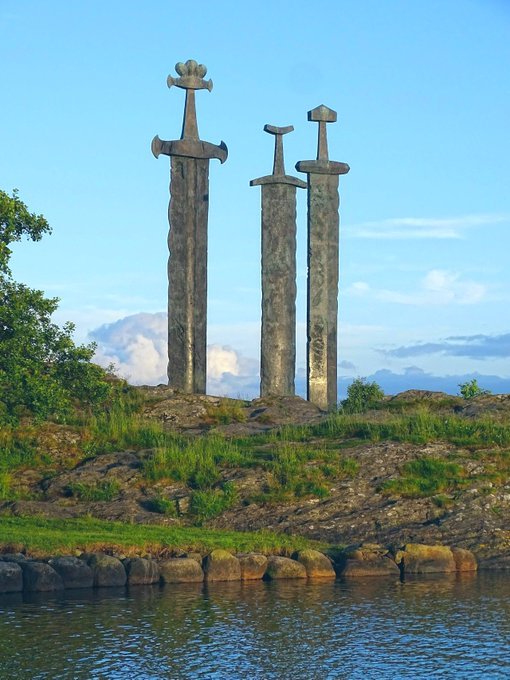
Sverd i fjell (Swords in Rock) commemorates the Battle of Hafrsfjord and unification of Norway by King Harald Fairhair in 872 CE. The three bronze swords stand at 9.20 meters high (30 ft).
160 notes
·
View notes
Note
Purely doing this because I'm autistic and think everyone wants to know, but it's not Harald Hardråde who takes Fjölnir's lands, because he died 170 years after that. It is more likely Hårfagre (Fairhair) :^) TBF to youse, I don't know many medieval English kings, either, and HHa WAS the most important one in your context
you vastly overestimate the number of Medieval English kings I know
38 notes
·
View notes
Text
Remember, medieval Iceland was an early attempt at anarcho-capitalist utopia. When Harald Fairhair declared himself King of Norway, the Norwegians who refused to bend the knee fled west to build a makeshift seastead on a frozen volcanic island. No lords, no kings, no masters. Only lawsuits. So, so many lawsuits.
-Your Book Review: Njal’s Saga
122 notes
·
View notes
Text
Harald Fairhair: Unification and Cultural Migration
This post was originally delivered as a virtual lecture to the New York Ancient Cultures MeetUp on September 20th, 2020. It was a group effort between myself (fjörn) and Joshua Gillingham (author of The Gatewatch). Below is the transcript I used while giving my portion of the talk. As such, I don’t have any footnotes, so I must apologize for my past neglect. I may return to add what I can, but for now I ask that you have trust in my own academic background.
Historical Sources
Poetic Propaganda?
Contemporary evidence about King Harald Fairhair, from the late-9th century, comes from his entourage of poets, who were called skáld in Old Norse. In the words of Bruce Lincoln, who wrote a wonderful (but somewhat expensive) book on this subject, they were his “propaganda corps.” But to speak of them with those terms alone would be an injustice, I think, to their actual reputation in Norse society, because they weren’t actually just hired goons spreading misleading information. Their craft actually required incredible skill, as Joshua will soon tell, and the importance of words, especially when skillfully sown, in shaping reputations cannot be understated.
The key to power and prestige in the medieval north was, more or less, a matter of public perception. This meant that poetry was a precious commodity in Norse society, because it could either enhance a person’s reputation or utterly destroy it. For instance, a skald might praise a person’s valor in battle, claiming that they had Odin’s blessing for victory and slew many of their foes without breaking a sweat. The result would be an image of a courageous warrior who ought not be lightly challenged. Yet, a skald could also slander a person, asserting that they were bested by their foe in an embarrassing or shameful way. This would therefore have the opposite effect, painting their foe as the heroic leader instead.
What made their poetry even more significant, though, was its connection to a specific occasion. Skalds acted as supposedly first-hand witnesses to great events, and it was part of their job to relay those events for others to hear. The results partially depended, rather cynically, upon who was giving them more coin—but also to protect themselves from potentially life-threatening wrath. Skalds thus recorded historical events, but often colored them to best suit their patrons. In other words, their poetry was less about recording history as an unbiased, uninvolved party, but rather about influencing public memory about an event and thus shaping the perception of the people it concerned.
[. . .]
☞ Continue reading (6,534 words / 35 minutes reading time) at fjorntheskald.com
17 notes
·
View notes
Note
Hi! I’m an agnostic with an interest in learning more about Norse polytheism, and I have a question about the way that the sagas and myths are interpreted.
Are the sagas (and other Norse myths) viewed as having actually happened at some point, or are they viewed more as symbolic/metaphorical, like a fable or an allegory?
Hi there! Thank you for the ask! This a topic I very much enjoy discussing, and I'll be glad to give you my thoughts on the matter.
Before I can properly explain what the sagas are, I'll determine what they aren't. They aren't to be confused with myths, such as the ones that make up nordic mythology. They are not part of that mythology for a plethora of reasons. While mythology pertains to deities we know have been worshipped as such at some point in time, the sagas are stories of human beings. More often than not, they mean to tell historical events, which represents a major difference with the myths. A saga often recounts the history of a particular dynasty, or family, and a lot of the characters who appear in them are either: 1. folk heroes, such as Wayland the Smith, who appears in the Þiðreks saga, or Sigurðr Sigmundsson, who appears in the Völsunga saga; Or 2. famous, historically attested figures, such as Erik the Red, whose story is told in the Eiríks saga rauða, or Harald Fairhair, who appears in Snorri's Haralds saga hárfagra.
This is another parrticularity which differentiates a myth and saga: the latter often brings to life real life historical figures, or even attested events. Still, these stories are steeped in folklore. They mix magic and history, and the line quickly blurs between reality and fiction. And considering that many of the sagas' authors remain unknown to this day (that is the case for the Icelanders' sagas), there is a limit to how much we can trust their writings. In fact, there is very little historical fact to be found in the sagas. However, some of the events they describe seem to hold some amout of truth! For example, it's speculated that the viking remains found in Dorset could have been the bodies of captured men who appear in the Jómsvíkinga saga. And Eirik the Red did in fact sail from Norway to Greenland and North America, making him and his crew the first Europpeans to land in the Americas. And when it comes to the stories of famous Scandinavian dynasties, the sagas serve to explain, using both fact and fiction, how this or that famous king has earned a throne.
Now, what makes these stories interesting to us as pagans? Well, as is often the case, the answer varies from one practionner to the next. To read the sagas is not a necessary part of the nordic pagan path. But to me, it helps to get to know the faith a little better. It allows us to better understand the cultural and historical context behind certain beliefs ad practices. They often showcase the very last accounts of ancient festivals, rituals, or famous temples. They are a tool of choice for many scholars, who, of course, are still forced to try and tell truth from fiction. But they're a fun read overall, and I highly recommend looking into them!
As for the myths, by which we mean the stories which compose what's called norse mythology, they are generally viewed as metaphors. They're a way for us to see our Gods come to life, and to find out some of their most prominent characteristics. The amount of credit you choose to put into mythology is entirely up to you, but I can confidently say that most pagans don't take them at face value. They're a fun way to help us imagine what the Gods might be like! For example, most agree that Týr is brave, Freyja, headstrong, and Frigg, caring. These are examples of details we can try to figure out if we read between the lines of these myths. What's most important to keep in mind, however, is the fact that many of these myths were heavily influenced by their authors. For example, Snorri, famously a Christian priest and Icelandic politician, would manipulate certain stories to better serve his political goals. It's widely accepted for example, that elements of the myths such as Angrboða and some other such lovers of the Gods were most likely invented during the 12th century, era during which a lot of the myths we know today were being compiled by priests. These changes often served to fill in the gaps left by a tradition of exclusively transmitting folklore orally. We can only speculate as to how much of the myths were truly part of pre-Christian oral tradition, which makes it even more relevant to exercise skepticism around mythology.
#ask#asks#norse paganism#norse gods#polytheism#spirituality#paganism#heathenry#deity work#deities#pagan#sagas#mythology#norse mythology
59 notes
·
View notes
Text
So...lately I decided to try something different...
I had a sudden urge... to create a handpuppet. Specifically one of the Norway-dragon I made a while ago. Why this one specifically? I don't know... but I wanna try!
I started by looking up tutorials on Youtube and it did not disappoint... Puppet Nerd had some great tips to get me started though I didn't follow his advice 100%... I still wanted to make this my own.

It all started with this sketch...

I moved on to making this base. Then I had to take a break because for some reason nobody sells blue fleece anymore for some reason?? At least not of the kind that actually fits with the red and white I already have...
Until I found a fleece carpet. Its not 100% the right type of fleece but its blue! So finally I was able to get started on his "skin"

Then came the question about how to make his mane... now making it out of faux fur... but then how would I make the stripes???
Well I decided to instead make things a whole lot harder for myself... and made it out of yarn...


Each strand is basically just tied up in knots on the inside of the fleece... yes it took forever...

Afterwards I went over it with a pet brush to make it look smoother and...less like yarn.

I then created his body, and did the same yarn method on the top of the front, to create a lion's mane.

This is where I'm at right now. He is constantly asking for hugs, as someone who doesn't like hugs its a bit uncomfortable...but I accept it because he's so very soft... (I stuffed his body and face with cotton filling in addition to the foam "skeleton" to make him look less pointy and more plump. That was a good call...except it makes his mouth a tad bit harder to move...but its still perfectly usable.)

His paws are biiiig... Armrods have been ordered.
I debated with myself I should give him more traditional puppet eyes, I even got some styrofoam balls to make them out of... but after checking how it would look with just pieces of paper I decided I prefer my usual method of creating puppet eyes... painting on a piece of fleece. The freckles are made with needle felting.
I also intend to give him legs, wings and feet, as the sketch implies. I haven't quite decided if I'm gonna do the antlers yet...cuz I haven't entirely decided what the best method to do that... For a while I pondered if I should do his crown too and if so how...then I remembered I have worbla-plastic, a heat gun and gold paint...I can easily make him a custom crown!
He has already been given a name btw...that isn't just Norway-puppet or Norway-Dragon...his name is Harald Hårfagre the second, named after a famous king (known as Fairhair in English) because...well have you seen his mane?? Its fabulous... best yarn hair in Norway. But you can call him Hairy Harry.
9 notes
·
View notes
Note
Anymore Lore on Liv x Ubba or King Fairhair?
So I’m gonna answer both of these.
More info below the cut!
Liv & Harald
Ship name: Livald. Haraliv.
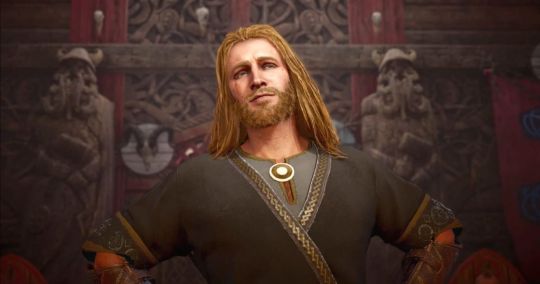

Not my photo by the way
For King Harald Fairhair, this “relationship” was arranged by both their fathers years earlier.
This was arranged because Edmund owed Harald’s father (Halfdan the Black according to the AC wiki) a favor, and as a way to strengthen both their families since Edmund is an apparent relative to King Burgred (hence why he was considered a traitor to the crown for fleeing Mercia/England, and marrying a Norse woman).
When Liv escaped Kjotve the Cruel, she was visited by Harald, and brought up their arranged marriage.
“What are you talking about, Your Grace?.” she asks, confused as to why King Harald would give her the time and day to visit her. Especially after she escaped the hand of Kjotve after all the abuse and torture he and Gorm did to her.
“I apologize for my unannounced visit, milady.” he says, “I don’t know if this was explained to you, but I’m sure your father will explain it.”
Liv plays with the sleeve cuff of her dress, “My father died, a long time ago.”
“My apologies for your loss. Your mother?.” he asks in the most sincere voice.
“She died 72 moons ago. 6 years ago.” she answers nervously, she never knew how to use the whole “many moons” type of thing.
“I’m sorry about your parents, but many years ago, my father and yours made an arrangement for both our families.” he explains to her.
“What arrangement?.” she asks, awkwardly shifting away from him, but not making it noticeable.
“We are arranged to be married, to strengthen both our families because your father, Edmund, was related to the Mercia dynasty.”
Raising her eyebrows, she never knew this information about her father, but then he died when she was 6 years old, so she didn’t know him very well, her mother never mentioned it to her. Unknown if she knew of this arrangement.
“My father? I- I didn’t know any of this. I've never been told about this.” she tells him, feeling like she was on the verge of crying. She started to feel overwhelmed, and Harald saw this. “Marry me, and you won’t have to be scared. You’ll always be protected, and you will be my queen.” he tells her, taking her hands in his. He has this gentle look in his eyes, but it seemed kinda off.
In a way, Liv did believe him, but she wanted to see it to believe it. She reluctantly agreed to take his hand and marry him. But this was just a plot for her to plan her next escape, if given the chance before she was married to him.
***********
Liv & Ubba
Ship name: Libba. Lubba. Livba

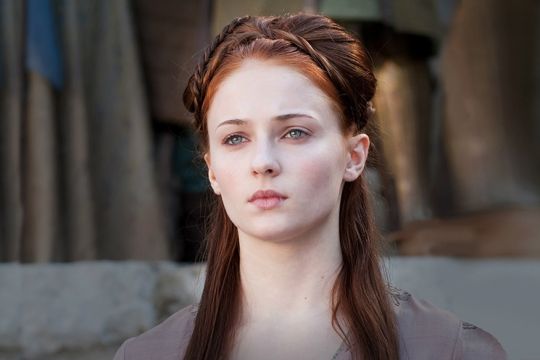
They met at a feast held by the Raven clan, Liv isn’t one to be social. She's an introvert. She's one to stand in the corner of the room and watch everyone else have fun. That's her way of having fun.
The drunkards making fools of themselves dancing, eating and singing very loudly. Celebrating very loudly. He approached her, as she was trying not to be seen, but who can miss her with 3 foxes by her side, and her bright copper hair. Not to mention, her lack of tattoos, her long beautiful dresses, and not looking like a viking, but having the mentality of one.
As he approaches her, she tries to not acknowledge him, but not wanting to be rude she gives him a smile. Drinking her mead, and looking down at her furry companions.
“Having fun?.” he asks her, leaning against the wall. Giving her a slight smile, how this man is Ivarr’s brother is beyond Liv’s knowledge. He’s handsome, tall. Taller than her by many, he towers over her and with his big build.
“Yeah, I am.” she responds, giving a smile back.
“Not gonna dance?.” he asks her, a hint of flirtatious in his tone, probably because he's been drinking, and probably wants to get with Liv.
“I’m not much of a dancer.” she tells him, feeling a little embarrassed. Looking away from him.
He lets out a laugh that can’t be heard over the sound of everyone else singing, laughing, and being loud in general. “Neither are these drunken fools.” he tells her as she finishes off her mead and sets down the cup. Finishing her 3rd cup. Feeling a little tipsy and very social.
“I don’t think they will remember anything tonight.” she tells him, feeling the mead hit her as she starts to move a little closer to Ubba. “They’re only good singers when they’re drowning in their mead.”
He takes her hand, “Dance with me.” Unable to protest against him, she follows him, not like she has any choice, she joins him and the others in the group dance of drunks. She had a great time, standing in the corner got a little boring anyway. Dancing and laughing with the members of the Raven clan.
Ubba lifted her up a few times in mid-dance, neither of them could remember, but according to Tove and Petra, Liv and Ubba did share a kiss that was interrupted by Ivarr, and his drunken state.
#oc: liv redfox#oc: liv eldrid#oc: liv grímsdóttir#king harald fairhair#ubba ragnarsson#ac: valhalla oc#assassins creed oc#assassins creed valhalla oc#my oc#assassins creed valhalla
18 notes
·
View notes
Note
hey you're posting about vikings you just woke up the nerd in me who adores the saga of ragnar and his sons and also i want to share my knowledge. so. you get a little vikings themed infodump. you know the scene where harald fairhair sings my mother told me during a raid? well i absolutely lost it when i heard it because it implies something fucking hilarious. so, before harald becomes king, and kind of after, he gets into a fight with a fellow called kvedulf. the specifics aren't important but kvedulf ends up fucking off to iceland to get away from harald because it gets blood-feud hot, and his son skallagrim and skallagrim's son egil fuck off with him.
egil wrote my mother told me, allegedly at seven years old. harald fairhair just casually singing a song written by his nemesis' baby grandson whilst on a raid. i don't know who made that decision but I've been chewing on it ever since. i want their number so i can ask questions.
thank you so much I am holding this fun piece of trivia like a fragile baby bird
12 notes
·
View notes
Text
Harald Taking Your Virginity Would Include...

In a way Harald would be very gentle with you while also getting what he wants out of doing this with you. He would make sure that you were comfortable, and you really wanted to do this with him before he even starts to touch you everywhere. When you nod and tell him you want to do this with him, he immediately starts going for your mouth and starts to make out with you but of course starts very slowly because he knows you have never even made out with any other man before. After a couple of minutes go by of making out kind of slowly, he starts to go by a little faster but also adds in a little bit of touching you a bit making sure that you comfortable with it. When he starts to roam all over your body with his hands he goes to the back of your dress and unties it. When he unties it he slowly takes it off of your shoulders and lets the dress drop all the way down to the floor. Because he did not want to make you uncomfortable, he picked you up and then set you on the bed in front of him then he started to take off his clothes beginning with his shirt. When he got his shirt off, he came down to you and put his knees on the floor to be on the same level as you then he started making out with you again still trying to make you feel comfortable. When you were making out with him, he put his hands on your thighs and started to spread them open because he had wanted to eat you out before he fucked you. When he did that you closed your legs really fast and told him that you were kind of insecure of yourself down there and he told you that it was completely fine and that there was nothing to be worried or insecure about. And that was enough for you to hear from him so you spread your legs open again and let him go between your legs. He had set you down more on your back while you put a pillow under your head to make it more comfortable while you laid on the bed. After he had laid you down on the bed he had gotten back down to his knees and went in between your legs and started to kiss the inside of your thighs and then finally kissing your clit and the rest of your pussy. He had started to lick your clit and suck on it as well. When he was sucking on your pussy like that, he had felt himself get hard, so he had to palm himself through his pants to be able to get through just a little longer while he ate you out. While he was eating you out, he had to basically hold you down because you had kept moving your hips up and down to get more of his tongue on your clit. After a couple minutes of him eating you out he had stopped because he thought that you were ready to be fucked for real now and so he got up and chuckled a bit when you had whined because he wasn't licking your pussy anymore. But even though you were whining that he left your pussy he got up and started to take off his pants slowly and then step out of them and out them on the floor next to his shirt. When he got his pants off, he had laid onto your back again and laid on top of you. When he did this, he had looked at you and had asked you if you still had wanted to do it and you nodded to him saying yes to him. After you had said yes, he had aligned his cock up with your pussy and had slowly put it in you. When he had put it in you both gasped because of the feeling of it. You were surprised actually because you thought that it would hurt. I mean you were really tight, and he was big inside of your pussy so you thought for sure that it would hurt for a little when he had put it in you. But it did not. It was more like that when he put it in it only hurt for a couple of seconds then it started to feel really good. He had gone slow in you for a couple minutes and tried to make sure that you were feeling good as well and then after those few minutes he had started going faster and faster inside of you and he started smiling when he saw you under him starting to moan a lot because of him inside of you. When he was going faster in you, he had started moaning a lot and loud as well. You knew that the people on the outside of your tent were hearing you both fucking hard.
He started going really hard in you when you had felt something in your stomach and it is something you had never really felt before so you thought that it was weird but Harald had noticed that you started becoming tighter around him so he went a little deeper and faster in your pussy because he thought that it meant you were going to cum soon and he was going to cum soon to so he wanted to go deeper and faster inside of you so that you both could cum together. And he was right because when he had started going deeper and faster in you, you had started twitching and screaming because he had felt so good in you. After a couple more of your twitches and becoming tighter around Harald you both had cum and started breathing heavily. After he cummed in you he had fell on top of you breathing heavily and smiled at you and looked at you because of how much he loved you. After a couple of minutes, you both laid down and started cuddling each other. You both got tired eventually so you both went to bed after cuddling for a while.
#harald finehair#harald x reader#norway#harald#scandanavia#harald fairhair#harald fairhair x reader#viking#vikings#imagines#vikings fandom#vikings headcanon#vikings imagine#viking imagines#harald finehair smut#king harald
96 notes
·
View notes
Text
30 Days of Bytham
(Basim ibn Ishaq/Hytham)
Day 3 - Prompt #17 - Royal
"There he is, the great royal himself," Sigurd sneers. "Harald Fairhair."
Beside him, Eivor shifts her weight from one foot to another. "More like a royal pain in the—"
"Behave," Basim murmurs, smiling when Sigurd barks out a laugh and even Hytham can't hold back his wheezing chuckle.
"Oh that's rich, coming from you!" Sigurd turns to Eivor gleefully. "Have I told you of my time at Constantinople, Sister?"
"You have yet to regale me with those tales, Brother," Eivor grins, eyes fixed on Basim, who shrugs with an exaggerated wave of his hands. "Sigurd will drag my name into the dirt, you must not trust everything he says, Eivor."
"And what of your Acolyte?" She asks, eyebrow raised at Hytham.
"Well," Hytham hedges, smile widening when he feels the hand squeezing his waist under his cloak, "all I can say is that not even a king's ransom would move Basim's name from where it already rests."
"And where does it rest?"
"Where does what rest?"
Eivor tuts impatiently. "Basim's name!"
"Why, Eivor," Hytham says sweetly, "I believe it rested on your tongue mere moments ago."
It does what Hytham hoped for: Basim laughs, loud and hearty, warm and golden, richer than the shiniest royal treasure.
-------------
Posted on AO3 here.
11 notes
·
View notes
Text
Thor (incomplete notes, expect edits)
Died seven winters after the Battle of Svolder (1x3)
...while "tracking beasts across the land" (ibid)
Norvegr (2x6)
Really hates "Danes"
Son married a "Danish" woman.
Died at age of 35 (2×14)
3 brothers, kin or fictive, fell in battle (2×16)
That's what we know.
Okay, so from what I'm reading on the Battle of Svolder (1000CE), these were the prominent figures:
Olaf Tryggvason ✝
Son of Tryggvi Olafsson, king of Viken (around Oslo) (Vingulmark, and Rånrike). Father was murdered, grew up in Orkney.
Long list of activities.
He took control of Norway in 995 CE.
Active promoter of Christianity in Norway, insisted vassals be baptized.
In 997, Olaf ✝ founded his seat of government in Trondheim, where he had first held a thing with the revolters against Haakon. It was a suitable site because the River Nid twisted itself before going into the fjord, creating a peninsula that could be easily defended against terrestrial attacks by only one short wall.
Olaf ✝ continued to promote Christianity throughout his reign. He baptized the explorer Leif Ericson ✝, who took a priest with him back to Greenland to convert the rest of his kin.[14] Olaf also converted the people and Earl of the Orkney Islands to Christianity.[15] At that time, the Orkney Islands were part of Norway.
It is only when Olaf Tryggvason ✝ sights Eirik Hákonarson's contingent that he realises he is in for a hard battle, because "they are Norwegians like us".
Eirik Hákonarson
Earl of Lade and son of Haakon Jarl.
Hákon Sigurðarson (Haakon Jarl) was a strong believer in the Old Norse gods, and when King Harald Bluetooth attempted to force Christianity upon him, Haakon broke his allegiance to Denmark. A Danish invasion force was defeated at the battle of Hjörungavágr in 986. According to Heimskringla, Eric, apparently reconciled with his father, commanded 60 ships in the battle and emerged victorious. After the battle he gave quarter to many of the Jomsvikings, including Vagn Ákason.
In 995, as Óláfr Tryggvason ✝ seized power as King of Norway, Eric was forced into exile in Sweden.
He allied himself with King Olof of Sweden and Sweyn ✝, the Christian king of the Danes, whose daughter, Gyða, he married. Using Sweden as his base he launched a series of raiding expeditions into the east.
Also needs to be considered: Haakon Jarl -
Haakon was a strong believer in the old Norse gods, even after Harald Bluetooth ✝ forced him to accept baptism around 975 and assigned him clergymen to take to Norway to spread Christianity. When a favourable wind came for Haakon to leave, he commanded the clergymen to return ashore,[4] and broke his allegiance to Denmark.
In 995, a quarrel broke out between Haakon and the Trønders just as Olaf Tryggvason ✝, a descendant of Harald Fairhair arrived. Haakon quickly lost all support, and was killed by his own slave and friend, Tormod Kark, while hiding in the pig sty in the farm Rimul in Melhus.
A number of (textually related) sources also recount Earl Haakon's predilection for raping women, whether the daughters of nobles or of commoners.
...It is clear that Svein Forkbeard ✝, Olaf the Swede and Eirik had ample reason to oppose Olaf Tryggvason ✝. Olaf had taken control of Viken in south Norway, an area long under Danish overlordship. Olaf and Svein had been in England together, but Olaf had made peace while Svein Forkbeard ✝ kept campaigning. Svein ✝ was on friendly terms with Olaf the Swede and connected to him by marriage, so the two were natural allies.[17] Finally, Jarl Eirik had been driven from his patrimony by Olaf Tryggvason ✝, as arguably had his father, Jarl Hakon, whom he may have wished to avenge.
In the Battle of Svolder in 1000, Eric, Sweyn, and Olof ambushed king Óláfr Tryggvason by the island of Svolder.
After the Battle of Svolder, the victorious leaders split Norway into areas of control. Heimskringla gives the most detailed account of the division, describing it as threefold. Olaf the Swede received four districts in Trondheim as well as Møre, Romsdal and Rånrike. He gave these to Jarl Svein Hákonarson, his son in law, to hold as a vassal. Svein Forkbeard ✝ gained possession of the Viken district, where Danish influence had long been strong. The rest of Norway was ruled by Eirik Hákonarson as Svein's vassal.[52] Fagrskinna, in contrast, says that the Swedish part consisted of Oppland and a part of Trondheim.
The Jarls Eirik and Svein proved strong, competent rulers, and their reign was prosperous. Most sources say that they adopted Christianity but allowed the people religious freedom, leading to a backlash against Christianity which undid much of Olaf Tryggvason's ✝ missionary work.
After Olaf's defeat at the Battle of Svolder in 1000 there was a partial return to paganism in Norway under the rule of the Jarls of Lade.
So. Prejudice against the Danes by Norwegians focuses on weakness in naval combat.
After spotting the enemy, Olaf might have used sail and oar to outrun the ambush and escape, but he refuses to flee and turns to give battle with the eleven ships immediately about him. Seeing the Danish fleet arrayed against him, he comments: "The forest goats will not overcome us, for the Danes have the courage of goats. We will not fear that force because the Danes have never carried off the victory if they fought on ships."
It is only when Olaf Tryggvason sights Eirik Hákonarson's contingent that he realises he is in for a hard battle, because "they are Norwegians like us".
The sagas give all the credit to the Norwegians, praising Eirik Hákonarson for any intelligence and for most of the valour shown by Olaf Tryggvason's opponents. The Danes and Swedes rush at the front of Olaf's line and are repulsed, suffering heavy casualties and loss of ships. Jarl Eirik attacks the flank and forces his vessel, the Iron Ram, up against the last ship of Olaf's line, which he clears with a fierce attack and then proceeds onto the next ship. In this way, Olaf's ships were cleared one by one, till the Long Serpent alone was left.
Thor's views of the Danes seem to jive more with a general prejudice of Danes by Norwegians.
With one exception, all of Norway's rulers since Håkon the Good (c. 920–961) were Christians (however Håkon later reverted to Heathenism as an apostate), as was Olaf's main opponent, Cnut the Great.
HOWEVER, his religion jives more with that of Haakon Jarl.
From the Norwegian wiki:
"Sigurd Ladejarl was hard to expose, and so was Håkon, his father. Sigurd held all the feasts on the king's behalf there in Trøndelag." [36] With this quotation, Snorri places the main seat of the old hill tribe precisely at Lade. Christianity was already well known in Norway at the time of Harald Hårfagre, and in the 9th century the new faith gained traction in parts of the population, but not in Trøndelag.
The Danish king, under strong pressure from the German-Roman emperor Otto II, had forced the earl to be baptized and sent priests with him to Norway. But as soon as Håkon was out of reach of the Danish king, he put the priests on shore and stood out as a complete heathen in the tradition of the Ladejarls. In the tribute quatrain Vellekla by the Icelandic bard Einar Skålaglam , earl Håkon is referred to as an advocate of the old religion, and he is considered among the last rulers in Norway to profess the Norse religion. According to Snorre, the earl is said to have declared himself a "Sæming" - that is, one of the sons of the warrior god Odin . "He should never seek out the fight, but also never shy away from the fight."
In Vellekla , Håkon is hailed as the one who brought åsatrua back to the Norwegians after the Christian kings Håkon the Good and Eirikssønnene: [37]
Wise Lord of the Army
let them ravage hofland
which Tor owned, again
regarded as temples of gods.
Even a Thor behind the shield
he led over the sea
to jotner's way of fighting
wolf. Him gods rule. [38]
Archaeologist Frans-Arne Stylegar nuances the image of the pagan Håkon by showing that during his raid in Gøtaland Håkon tore down and robbed a hoof that was dedicated to the god Thor . Odd Snorresson (Odd Munk) writes that Gautland earl Ottar had Håkon declared "varg i veum" (wolf in the sanctuary) at the court after the crime. [39]He also mentions that Harald of Denmark is said to have sent German missionaries to Norway. Håkon's role in this connection is unclear, but there are clear archaeological traces that indicate that Christianity gained a foothold in the country at this time. Stylegar claims that "the trend at this time was to fill political alliances and subordination relationships with Christian, ideological content. Such was the relationship between Emperor Otto and King Harald, and this may well have been the case between Harald and earl Håkon as well." [40] In other words, it is conceivable that earl Håkon became a Christian in his older days for purely political and opportune reasons.
A distinctive feature of earl Håkon's worship of the gods is the relationship with the goddess, the guardian spirit or the valkyrie Torgerd Holgebrud . Especially during the Battle of Hjørungavåg, she has a central role. Things went badly for Håkon at the beginning of the battle and he invoked his patron saint. She demanded a large sacrifice, and Håkon had his seven-year-old son Erling killed. The battle then turned and Håkon won with the help of Torgerd and her sister Irpa. Torgerd also has an important role in connection with Håkon's revenge on Torleiv Jarleskald. [41] [42] The cult around Torgerd is also known from Icelandic sources.
Thor, he's... probably early 30s???
Seven years after the Battle of Svolder, that would mean he'd have been in his early twenties then.
Usually, by the time you have a wife and child, you'd not be going off on that kind of long-range expedition. And seriously, that's long range. Norvegr to Iceland is about a week under ideal conditions, but using the easier island hopping route could take weeks, and 3 to 4 weeks from Norway to Greenland if they had a sunstone.
See:
It all depends on where they left from of course. Traditionally it was said that a journey from the west coast of Norway to Iceland would take about 7 days, while the journey from the west coast of Norway and over to Ireland would be about 3 days of sailing.
Despite the distance being almost the same as from Norway, the journey to Iceland was also said to be just 3 days journey from Dublin in Ireland, which was one of the major viking trading cities in Europe at the time. This was probably due to the favourable wind and currents along the gulf stream.
There was therefore much contact between Iceland and Dublin, especially for trade in valuable goods such as walrus ropes and walrus oils, both uniquely suited for ship-building and maintenance, which were difficult to acquire anywhere else than Iceland and far Siberia. On the return voyage the most valuable commodity brought was slaves, since the hunting and extraction of oil, skin and meat from walrusses were a tiresome job, but various farm animals, foodstuffs such as grains, as well as weapons and fine linens were also in high demand.
Sources and more details on the economics of viking age Iceland and Ireland can be found in "Den svarte vikingen" by Bergsveinn Birgisson.
However:
The journey from Greenland to the settlement in Vinland is more than 3000 km long and would likely have taken the Vikings a minimum of two weeks (and possibly even six weeks or longer) to complete, one-way.
Norway to Iceland: Half the sailing season (May to September). Iceland to Greenland: ???.
Traveling to Vinland would likely have taken at least two years. Thor had to have a reason to be absent for so long, and reason to think he was coming back.
My thought? Politics or religion. But maybe it was, simply, economics. Perhaps he was even trying to pave the way for his family.
Timeline
c. 982 - Erik the Red discovers Greenland for the Norse knowledge base.
c. 985 - Norse settlement of Greenland
986 - summer - Bjarni Herjólfsson relays sighting of hospitable lands to west of Greenland
995 - Haakon Jarl killed. In the chaos Olaf Tryggvasson ✝ takes over.
1000 - Leif Eriksson ✝ explores the land Bjarni described and overwinters.
999/1000 - September - Battle of Svolder. Olaf Tryggvasson ✝ killed. Christianizaion of Norway slowed due to Eirik Hákonarson and Svein Forkbeard permitting greater religious freedom.
999/1000 - First winter hence
1000/1001 - Second winter hence
1001/1002 - third winter hence
1002/1003 - fourth winter hence
1003/1004 - fifth winter hence
1004/1005 - sixth winter hence
1005/1006 - seventh winter hence.
1006/1007 - At this point Thor is killed by lightning. Light or lack of snow in scene suggests spring.
Key
To ease remembering who is allied with who, I'm going to mark Christianized Norse with this symbol ✝ following their names. 🔨 is for those who favored the Norse pantheon, and both are for those who are unidentified. Notation will be completed later.
9 notes
·
View notes